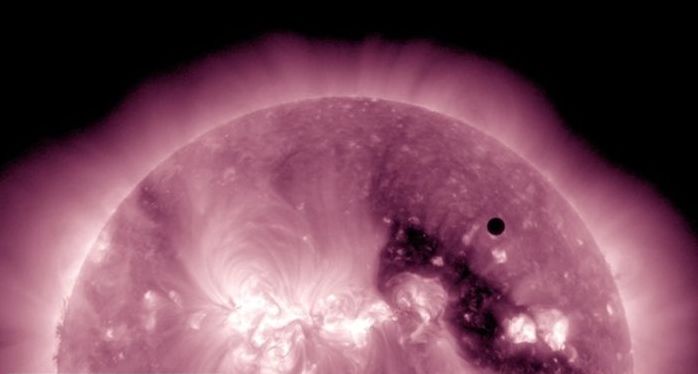|
|
Transit Of Venus Across The Sun
|
• 1639 – first scientific observation
The first recorded observation of a transit of Venus was made by Jeremiah Horrocks from his home at Carr House in Much Hoole, near Preston in England, on 4 December 1639 (24 November under the Julian calendar then in use in England). His friend, William Crabtree, also observed this transit from Broughton, near Manchester. Kepler had predicted transits in 1631 and 1761 and a near miss in 1639. Horrocks corrected Kepler's calculation for the orbit of Venus, realized that transits of Venus would occur in pairs 8 years apart, and so predicted the transit in 1639. Although he was uncertain of the exact time, he calculated that the transit was to begin at approximately 3:00 pm. Horrocks focused the image of the Sun through a simple telescope onto a piece of paper, where the image could be safely observed. After observing for most of the day, he was lucky to see the transit as clouds obscuring the Sun cleared at about 3:15 pm, just half an hour before sunset. Horrocks' observations allowed him to make a well-informed guess as to the size of Venus, as well as to make an estimate of the distance between the Earth and the Sun. He estimated that distance to be 59.4 million miles (95.6 Gm, 0.639 AU) – about two thirds of the actual distance of 93 million miles (149.6 million km), but a more accurate figure than any suggested up to that time. The observations were not published until 1661, well after Horrocks' death.
• 1761 and 1769
In 1663 Scottish mathematician James Gregory had suggested in his Optica Promota that observations of a transit of the planet Mercury, at widely spaced points on the surface of the Earth, could be used to calculate the solar parallax and hence the astronomical unit. Aware of this, a young Edmond Halley made observations of such a transit in 1676 from Saint Helena, but was disappointed to find that there had been only one other observation of the event and was not satisfied that the resulting calculation of the solar parallax at 45" was accurate. In a paper published in 1691, and a more refined one in 1716, he proposed that more accurate calculations could be made using measurements of a transit of Venus, although the next such event was not due until 1761. Halley died in 1742, but in 1761 numerous expeditions were made to various parts of the world so that precise observations of the transit could be made in order to make the calculations as described by Halley—an early example of international scientific collaboration. In an attempt to observe the first transit of the pair, scientists and explorers from Britain, Austria and France travelled to destinations around the world, including Siberia, Norway, Newfoundland and Madagascar. Most managed to observe at least part of the transit, but successful observations were made in particular by Jeremiah Dixon and Charles Mason at the Cape of Good Hope.
|
|









